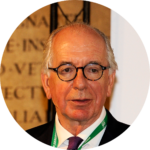| “… humiliation because the hotel refused to change his USD travellers cheque … ”
On that day I was on a UN mission in Tonga. I came down to breakfast and found my US colleague fuming with rage and humiliation because the hotel had refused to change his USD travellers cheque. Tonga being 13 hours ahead of GMT (!), he must have been among the first of his compatriots to be thus confronted with the evident reality that in a market economy any good or service is simply worth what the market thinks it’s worth. As a professor of economics supportive of the principles of the market economy, I was cock-a-hoop: they had scored a point in the form of floating exchange rates.
Edouard Dommen
Specialist in economic ethics, former university professor and researcher in UNCTAD and president of Geneva’s Ecumenical Workshop in Theology
|
 |
| “… the exchange risks were transferred from the States to the economic actors … ”
At the beginning of 1971, our teacher of monetary economics announced all the expected benefits of floating exchange rates: elimination of foreign exchange reserves, reintroduction of American monetary policy into the common system, day-to-day adjustment of the effective commercial powers of the various nations. We quickly had to be disillusioned. The exchange risks were transferred from the States to the economic actors. To limit these deleterious variations for all economies, it was necessary to institute active monetary policies. Suddenly the incessant variations of exchange rates and interest rates have generated the creation of multiple financial instruments for hedging risk, with the perverse effects that we know concerning speculation. Suddenly, the monetary policies of the main currencies, mainly the dollar, then, to a lesser extent the yen and the yuan, became the problem of all the other nations.
Etienne Perrot
Jesuit, Dr. Economics sciences, editorial board of the magazine Choisir (Geneva), editorial adviser of the journal Études (Paris)
|
 |
| “… the whole system became a world financial casino …”
The end of convertibility in 1971 was not so much about “fighting the currency speculators” as about the fact that the US had been printing money far beyond Fort Knox gold reserves. Jean Jacques Servan-Schreiber made it clear at the time, with The American Challenge. De Gaulle complained “nous les payons pour qu’ils nous achètent.” And the US continues printing money, a world privilege. With the end of the Glass-Steagall regulation of banking in 1999, and the substitution of government-printed money with bank-emitted digital money through credit, the whole system became a world financial casino. Debt is exploding, over 100% of world GDP. Poor countries are being squeezed out. The world needs a new Bretton Woods, not economic war.
Ladislau Dowbor
Economist, professor at the Catholic University of São Paulo, consultant to a number of international agencies
|
 |
| “… floating rate offers some policy autonomy, though less than we used to think …”
A floating exchange rate is A solution, but not THE solution. Then again, no single element of a policy framework is THE solution. A vast body of research has shown that a floating rate offers some policy autonomy, though less than we used to think. It works best when accompanied with other tools, such as macroprudential policy and capital flow management, and research has led to substantial progress in our understanding of how to use them. Anchoring policy to another country through a fixed exchange rate can make sense, but only as part of a broader political project or if the odds of developing solid domestic policy institutions are too limited.
Cédric Tille
Professor of macroeconomics at the Graduate Institute of International and Development Studies in Geneva
|
 |
| “… floating exchange rates are more of a solution than a problem …”
I believe floating exchange rates are more of a solution than a problem. Under a fixed exchange rate, central banks frequently must intervene in foreign exchange markets to protect the gold parity that’s why periods of fixed exchange rates were frequently characterized by currency crises. During those periods, too much pressure was put on central banks to devalue or revalue the country’s currency. Problems are worse when country’s attempt to devalue a currency by giving out too much of it that normally ended up economies running out of the currency.Floating exchange rates have a disadvantage creating higher market volatility, but its benefits outweigh the problems.
John Francis Diaz
Associate Professor of Finance at Chung Yuan Christian University, Taiwan
|
 |
| “… the countries of the Euro chose to surpass fixed exchange rates …”
As Zhou Enlai on the French Revolution: it’s “too early to say” whether floating exchange rates are a solution, a problem, or parts of both. After abandoning the Dollar Standard, large countries had several agreements and disagreements, while some smaller countries experienced with fixed exchange rates. There are probably more advantages with flexibility, but in the meantime the countries of the Euro chose to surpass fixed exchange rates and adventure into unknown territory with a common currency… Seen from the point of view of a comparatively weak party of the group like Spain, the gains of monetary stability within the Euro largely make up for possible drawbacks. Whether lessons can be drawn for other regions is open for discussion.
Domingo Sugranyes
Director of a seminar on ethics and technology at Pablo VI Foundation, past Executive Vice-Chairman of MAPFRE international insurance group
|
 |
| “… high interest rates that strangled developing countries … ”
I was working that day in Southampton New York, when the radio announced the demise of the gold dollar standard. What would happen was uncertain. Nobody expected a major depreciation of the dollar, with a sharp revaluation of the European currencies and a sharp jump in oil prices. The creation of the ECU the following year was also news as European countries decided to use their own currencies to trade amongst themselves. The high inflation rate of the 70’s and the FED’s anti-inflationary policies led to very high interest rates that strangled developing countries. Worse as there is a confirmed inverse relationship between interest rates and commodity prices leading the emerging markets into a growth terrain, dependent on the FED.
Oscar Ugarteche
Visiting professor of Economics in various universities
|
 |
| “… we cannot return to the gold standard … ”
I have no memory of that fateful August day in 1971, being in Malaysia, and busy with homework and merry friendships. (We derided Nixon as the US President perpetuating the Vietnam war.) Still, Nixon’s decision to float exchange rates has seemingly, over the last 50 years, contributed to extraordinary economic growth, financial market volatility, and exalted central bank power. Despite talk of a link between inflation (not a problem for decades) and floating exchange rates, we cannot return to the gold standard. There isn’t enough gold, nor do we want to excavate and melt the metal in light of net-zero climate goals. If stepping back in time doesn’t provide solutions, perhaps we should consider a hybrid monetary future consisting of fiat currencies and cryptocurrencies.
Kara Tan Bhala
President and Founder of Seven Pillars Institute for Global Finance and Ethics
|
 |
| “… policy guidelines rather than the new systemic blueprint … ”
The suspension of the convertibility of the USD into gold was followed by several countries’ abandonment of their commitments to exchange-rate parities for their currencies and in December 1971 by an agreement on realignment of the currencies of member countries of the Group of Ten. This realignment failed to end pressures on the USD, and in March 1973 the central banks of countries of the Group of Ten and the European Economic Community abandoned their commitment to intervene in exchange markets to maintain stable exchange rates with the USD, thus ending the Bretton Woods par-value system. Negotiations had started as early as July 1972 but produced policy guidelines rather than the new systemic blueprint hoped for by some. Henceforth international policymaking regarding exchange rates and monetary movements became more politicised with outcomes resembling truces rather than longer-term settlements.
Andrew Cornford
Counsellor, Observatoire de la Finance; past staff member of UNCTAD, with special responsibility for financial regulation and international trade in financial services
|
 |
| “… the unsustainable value of the dollar became increasingly apparent …”
From 1969 onward, until Nixon’s announcement of suspension of gold convertibility on 15 August 1971, the unsustainable value of the dollar became increasingly apparent, while the anxiety only became intense in 1971 after interest rates had come down in the 1970 recession. Nixon’s administration suspended gold convertibility of the dollar. In the early 1970s, Nixon’s government took a tough course on the collective management of dollar-based monetary systems. The instant focus was on an exchange rate rearrangement, which was the objective of Nixon’s closing of the gold pane and transitory import surcharge. During the 1990s till date, international financial regulatory issues have insisted upon increasing multilateral attention.
Archana Sinha
Head, Department of Women’s Studies, Indian Social Institute, New Delhi, India
|
 |
 Question asked : “Half a century ago, on Sunday evening of 15h August 1971, president Nixon, “fighting the currency speculators”, has “suspended” the convertibility of the USD into gold (Nixon speech is available here https://www.youtube.com/watch?v=ye4uRvkAPhA). The 1971 decision has opened a new – still unfinished – chapter in world economic, monetary and financial history. Please share with us your thoughts – memories, lessons, dreams – related to this 50th anniversary. Are floating exchange rates the solution or are they the problem for the world of today?”
Question asked : “Half a century ago, on Sunday evening of 15h August 1971, president Nixon, “fighting the currency speculators”, has “suspended” the convertibility of the USD into gold (Nixon speech is available here https://www.youtube.com/watch?v=ye4uRvkAPhA). The 1971 decision has opened a new – still unfinished – chapter in world economic, monetary and financial history. Please share with us your thoughts – memories, lessons, dreams – related to this 50th anniversary. Are floating exchange rates the solution or are they the problem for the world of today?”












